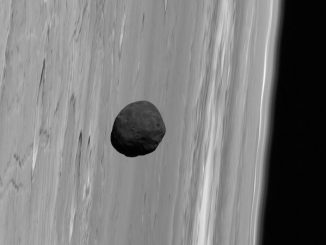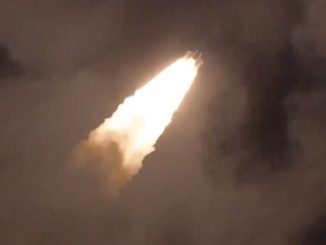[CRA2] Crater formation where the Small Carry-on Impactor collided with Ryugu has been confirmed! These images compare the surface before and after the SCI collision. pic.twitter.com/BZPYlHhSjs
— HAYABUSA2@JAXA (@haya2e_jaxa) April 25, 2019
New images from Japan’s Hayabusa 2 spacecraft show the location of a fresh crater carved from the jagged terrain of asteroid Ryugu by an explosive charge dropped on the tiny world’s rocky surface earlier this month.
The Hayabusa 2 probe has passed the halfway mark in its year-and-a-half-long exploration of Ryugu. After collecting its first sample from the asteroid’s surface in February, Hayabusa 2 maneuvered into position over a different part of Ryugu and released an impactor April 4 to create an artificial crater, exposing pristine subsurface rocks for the spacecraft to examine and retrieve in the coming weeks.
An explosive charge drove the 12-inch (30-centimeter) copper impactor into the asteroid at high speed, striking Ryuku’s surface with enough energy to leave a marking some 66 feet (20 meters) in diameter.
That is twice the size of the crater scientists expected from the impact.
Images downlinked by the Hayabusa 2 spacecraft April 25 revealed the impact site for the first time. After deploying the impactor earlier this month, probe initially flew behind the asteroid to avoid any debris kicked up by the crater-forming collision, then returned to a “home position” around 12 miles (20 kilometers) from the asteroid.
Hayabusa 2 also released a camera to stay closer to the impactor. Pictures relayed from the camera through the Hayabusa 2 spacecraft back to Earth showed a grainy view of a shower of particles thrown away from the asteroid by the impactor.
The image confirmed the impactor struck Ryugu, but scientists did not know how big of a crater it created.
Ground controllers at the Japan Aerospace Exploration Agency, which developed the Hayabusa 2 mission, commanded the spacecraft to move closer to Ryugu last week to search for the new crater.
Hayabusa 2 surveyed the impact site from a distance of about 1 mile (1.6 kilometers).
“The exact size and shape of the artificial crater will be examined in detail in the future, but we can see that terrain of an area about 20 meters wide has changed,” officials tweeted through the Hayabusa 2 mission’s official Twitter account. “We did not expect such a big alteration so a lively debate has been initiated in the project!”
The device used to created the artificial crater was called the Small Carry-On Impactor, and it was one of several deployable modules carried to Ryugu by Hayabusa 2. Last year, Hayabusa 2 released three landers to explore the 3,000-foot-wide (900-meter) asteroid’s surface.
Rocky debris blasted away by the impactor’s collision was expected to expose materials from inside the asteroid, where rock specimens are shielded from radiation and other weathering affects from sunlight and extreme temperature swings. Scientists hope Hayabusa 2 can pick up a sample from the crater in the coming weeks and bring the rocks back to Earth, along with rocks gathered from the asteroid’s surface earlier this year.
Hayabusa 2 arrived at Ryugu last June, and is set to depart the asteroid in November or December for the return cruise to Earth. The spacecraft will jettison a re-entry capsule protected by a thermal shield to plunge into Earth’s atmosphere in December 2020, when the return craft will parachute to a landing in Australia.
Scientists will transfer the asteroid specimens to laboratories for detailed analysis in hopes of learning more about the history of the solar system.
Email the author.
Follow Stephen Clark on Twitter: @StephenClark1.



